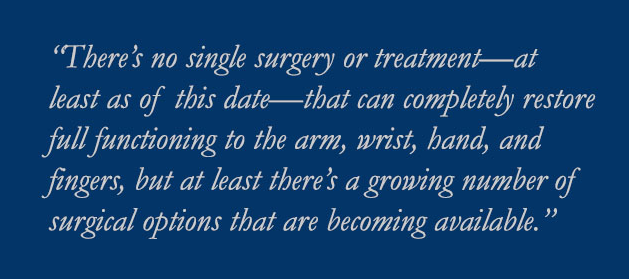In the past, children with Erb’s Palsy were typically offered three surgical options: nerve grafting, external neurolysis, and nerve transfers. There were, and are, other procedures available, but these are three of the most commonly performed.
Nerve grafting. Nerve grafting involves harvesting a nerve from one part of the body and grafting it onto the damaged nerve. The sural nerve is commonly used, but other nerves can be grafted as well. The grafted nerve, over a period of weeks and months, provides a pathway for nerve regeneration.
External neurolysis. External neurolysis is a surgical procedure that removes external scaring from around the nerve. It’s usually used in combination with other procedures. Removal of scar tissue is important because external scarring can over time actually cause internal scarring.
Nerve transfers. Nerve transfers take a nerve from one part of the body and transfer it to restore function to an area where another nerve has been damaged. Often the surgeon will use nerves that are close to the injured area, and these nerves are then transferred at or near the injured nerve. An “intraplexual” transfer takes the donor nerve from the brachial plexus itself whereas an “extraplexual” transfer takes the donor nerve outside the brachial plexus.
Biceps tendon lengthening surgery. A recent article1 references a new surgical procedure known as biceps tendon lengthening (BTL) surgery.
“We have performed biceps tendon lengthening (BTL),” the authors write, “using a Z-plasty technique on OBPI [obstetric brachial plexus injury patients] patients aged 4 years to adulthood, who had been diagnosed with biceps tendon fixed flexion contractures. Ulnar, radial, and median nerve decompression was also performed at the same sitting.”
After these procedures, the authors describe significant improvement: “Mean flexion contracture was 35° (30°–45°) preoperatively, which was improved to 0°–10° postoperatively with an average follow-up of 7 (4–11) months.” Further, they note: “This surgical procedure corrected the elbow flexion contractures, about an average of 25° and an improved length almost to normal, and improved the upper extremity functions. Neurophysiological data showed significant improvement in conduction of all three nerves tested after neurolysis. Further, median and radial nerve amplitude increase was statistically significant.”
“Statistically significant improvement in biceps length as well as nerve conduction was observed after the surgery,” the authors conclude. “None of the children in our study lost biceps function, although weakness of the biceps is both a short- and long-term risk associated with biceps lengthening.”2
As of this date, this BTL surgery is still new and has not become mainstream, but in the future it may have a role for children with Erb’s Palsy who suffer persistent flexion contractures. All surgeries involving the brachial plexus seek to restore some degree of appearance, strength, dexterity, and functioning. There’s no single surgery or treatment—at least as of this date—that can completely restore full functioning to the arm, wrist, hand, and fingers, but at least there’s a growing number of surgical options that are becoming available.
1 R. Nath, et al., Significant improvement in nerve conduction, arm length, and upper extremity function after intraoperative electrical stimulation, neurolysis, and biceps tendon lengthening in obstetric brachial plexus patients, J Orthop Surg Res. 10:51 (April 2015).
2 A more recent article by the same authors describes similar findings. See R. Nath, Lengthening Surgery for Failed Serial Casting Patients With Elbow Flexion Contractures Following Brachial Plexus Birth Injury, Eplasty. 2016; 16:e24 (August 2016)(“These OBPI patients in our study had not only 75% and a significant reduction in EFCs [elbow flexion contractures]and they also achieved an improved and more normal length of the affected arm after the BTL surgery when compared to only 7% insignificant improvement and no change in arm length after serial casting.”)




